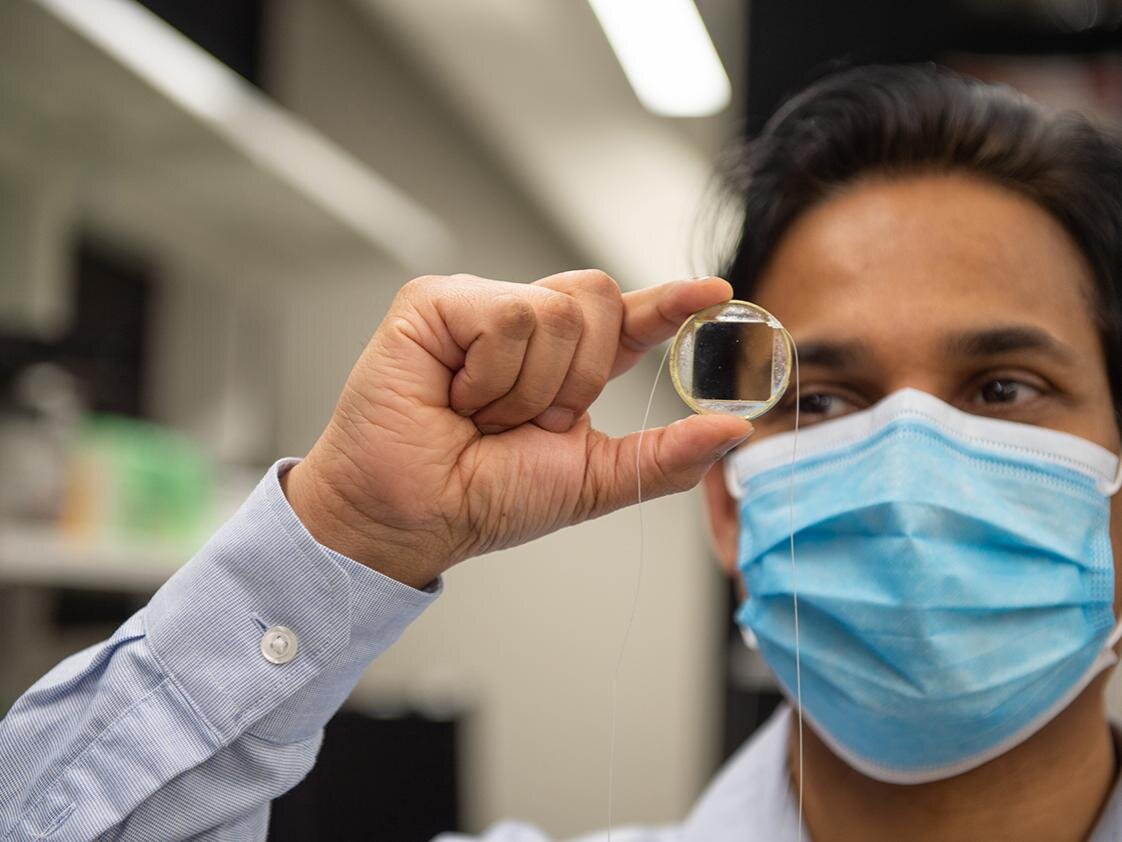A transparent, biocompatible ultrasound transducer chip developed by researchers from Penn State is opening opportunities in cell and tissue stimulation and multimodal imaging. The chip, called a transparent ultrasound transducer (TUT), resembles a microscope slide and exhibits greater than 80% transparency. Cells can be cultured and stimulated directly on top of the transducer chip, and the cells’ resulting changes can be imaged with optical microscopy techniques.
“In the conventional ultrasound stimulation experiments, a cell culture dish is placed in a water bath, and a bulky ultrasound transducer directs the ultrasound waves to the cells through the water medium,” said Sri-Rajasekhar “Raj” Kothapalli, principal investigator and assistant professor of biomedical engineering. “This was a complex setup that didn’t provide reproducible results: The results that one group saw another did not, even while using the same parameters, because there are several things that could affect the cells’ survival and stimulation while they are in water, as well as how we visualize them.”

Sri-Rajasekhar 'Raj' Kothapalli, assistant professor of biomedical engineering at Penn State, holds an optically transparent, biocompatible ultrasound transducer chip. The technology has implications for cancer and stem cell research. Courtesy of Kelby Hochreither/Penn State.
Kothapalli and his team miniaturized the ultrasound stimulation setup by creating a transparent transducer platform made of a piezoelectric lithium niobate material. Piezoelectric materials generate mechanical energy when an electric current is applied. The chip’s biocompatible surface enables the cells to be cultured directly on the device and used for repeated stimulation experiments over several weeks.
When connected to a power supply, the transducer emits ultrasound waves, which pulse the cells and trigger ion influx and outflux.
According to Kothapalli, the technology can be directly inserted into any optical microscope.
“Our current TUTs have dimensions of 2 × 2 × 2 mm, and we are currently further reducing thickness to 0.17 mm, which is typical cover glass thickness,” Kothapalli said.
To test the setup, Kothapalli and his team cultured bladder cancer cells on the chip. They then inserted fluorescent calcium indicators into the cells to allow researchers to clearly see dynamic changes in cell calcium signaling under the microscope during stimulation.

“Since the cells are directly sitting on the transparent transducer surface, we can confirm that all the cells are equally stimulated at the same time using a single ultrasound stimulus, unlike conventional approaches,” said Kothapalli, a co-hire with the Penn State Cancer Institute. “And unlike earlier processes, we can get high-resolution images of many cells at once in a single field of view, because we are able to see the cells from a close distance.”
Through the bladder cancer cell study, researchers established proof-of-concept for the new transducer setup. But they can extend these findings to use the transducer setup in potential future applications, according to Kothapalli, such as stem cell differentiation, mechanosensitive neuromodulation, drug delivery, and the opening of the blood-brain barrier.
“From a research perspective, TUTs allow several in vitro and in vivo applications that combine cell/tissue stimulation with multimodal imaging,” Kothapalli said. “For example, ultrasound-induced mechanical stimulation is widely investigated for studying stem cell differentiation, difference in mechanobiology of aggressive and nonaggressive cancer cells, drug delivery, blood-brain barrier opening, and neuromodulation.”
In one application, the team implanted a TUT under a mouse skull to serve as a transparent cranial window, which then allowed multimodal photoacoustic and optical imaging of the brain.
“The state-of-the-art photoacoustic microscopy (PAM) systems use conventional ultrasound transducers that are not transparent to light. As a result, the light is directed around the transducer,” Kothapalli said. This leads to a very bulky setup. The implantable transducer greatly simplifies the imaging setup, and it also facilitates probing the animal’s brain in an awake state.
In another application, the team developed a TUT linear array that allowed real-time fluorescence, B-mode ultrasound, Doppler ultrasound, and photoacoustic imaging of deep tissue.
According to Kothapalli, the team has patented the TUT technology for stimulation and imaging applications. It is currently focusing on applications with commercial potential, he said.
The research was published in Lab on a Chip (www.doi.org/10.1039/D1LC00667C) and Optics Letters (www.doi.org/10.1364/OL.450648).